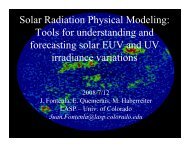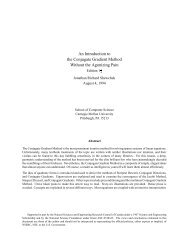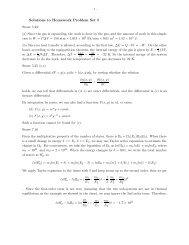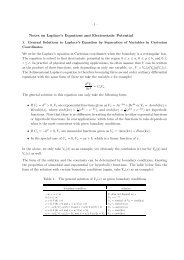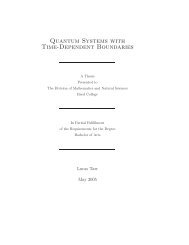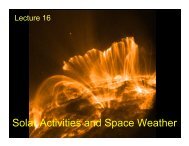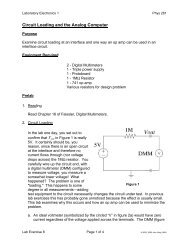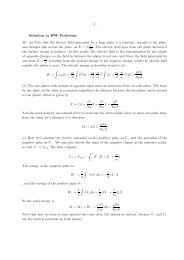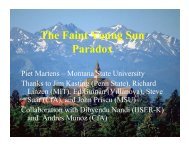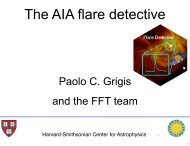312 Lab Manual - Solar Physics at MSU - Montana State University
312 Lab Manual - Solar Physics at MSU - Montana State University
312 Lab Manual - Solar Physics at MSU - Montana State University
You also want an ePaper? Increase the reach of your titles
YUMPU automatically turns print PDFs into web optimized ePapers that Google loves.
Table D<br />
Star Type M m<br />
Sun G2 4.8 -26.8<br />
Proxima Centauri M5 15.4 0.1<br />
Alpha Centauri A G2 4.4 1.5<br />
Alpha Centauri B K5 5.8 11.0<br />
Barnard's Star M5 13.2 9.5<br />
Wolf 359 M6 16.7 13.5<br />
Lalande 21185 M2 10.5 7.5<br />
Sirius A A1 1.5 -1.4<br />
Luyten 726-8A M6 15.3 12.5<br />
Luyten 726-8B M6 15.8 13.0<br />
Ross 154 M5 13.3 10.6<br />
Epsilon Eridani K2 6.1 3.7<br />
Luyten 789-6 M6 14.6 12.2<br />
Ross 128 M5 13.5 11.1<br />
61 Cygni A K5 7.5 5.2<br />
61 Cygni B K7 8.3 6.0<br />
Epsilon Indi K5 7.0 4.7<br />
Procyon A F5 2.7 0.3<br />
Cincinn<strong>at</strong>i 2456A M4 11.2 8.9<br />
Cincinn<strong>at</strong>i 2456B M4 12.0 9.7<br />
Groombridge 34A M1 10.4 8.1<br />
Groombridge 34B M6 13.3 11.0<br />
Lacaille 9352 M2 9.6 7.4<br />
Tau Ceti G8 5.7 3.5<br />
Luyten's Star M4 11.9 9.8<br />
Lacaille 8760 M1 8.8 6.7<br />
Kapteyn's Star M0 10.8 8.8<br />
Kruger 60A M4 11.7 9.7<br />
Kruger 60B M6 13.2 11.2<br />
•Questions<br />
Answer the following questions on a separ<strong>at</strong>e<br />
piece of paper. For credit, turn your answers<br />
and your plots.<br />
1. Why don’t the stars in Table B lie on the curve<br />
you cre<strong>at</strong>ed in part A) ?<br />
2. How many magnitudes is Capella brighter<br />
than the Sun?<br />
3. How many times brighter is Capella than the<br />
Sun?<br />
4. Is Capella larger or smaller than the Sun?<br />
5. Wh<strong>at</strong> is the most common kind of bright (M)<br />
star (hot, cool, or spectral type)?<br />
6. Estim<strong>at</strong>e the average apparent magnitude,<br />
m, of the brightest stars (Table C).<br />
7. When you look <strong>at</strong> a bright star in the sky,<br />
your probably looking <strong>at</strong> wh<strong>at</strong> speectral type of<br />
star?<br />
8. Wh<strong>at</strong> is the most common kind of star near<br />
the Sun?<br />
9. Estim<strong>at</strong>e the average apparent magnitude<br />
of the close stars (Table D).<br />
10. We believe the stars near the sun are ordinary,<br />
common stars. Why don’t we see mostly<br />
common stars?<br />
11. Wh<strong>at</strong> would our night sky look like if all the<br />
stars in the galaxy had the same absolute magnitude<br />
as the Sun?<br />
12. Write a short summary of wh<strong>at</strong> you learned<br />
in the lab.<br />
The H-R Diagram<br />
19



